A Study on the Effect of Nighttime Light Intrusion on the Phase Shift of Human Rhythms
Abstract
1. Introduction
2. Preliminary Research
2.1. Research Subjects
2.1.1. Selection of Field Measurement Objects
2.1.2. Subjective Questionnaire Respondents
2.2. Research Methodology
2.2.1. Field Measurements
2.2.2. Questionnaire
- (1)
- Questionnaire design for a survey on sources of nocturnal light exposure and the current status of human sleep.
- (2)
- Questionnaire design for the subjective perception of the infested population towards the source of infestation.
2.3. Survey Results
2.3.1. Actual Measurement Results
- (1)
- LED advertising screen brightness
- (2)
- Screen change frequency
- (3)
- LED advertising screen color and light data
2.3.2. Questionnaire Data Results
- (1)
- Data analysis of the questionnaire on sources of nocturnal light exposure and the current state of human sleep.
- (2)
- Analysis of questionnaire data on the subjective perception of the infestation source by the infested population.
2.4. Summary
3. Experimental Methods
3.1. Subjects
3.2. Experimental Program
3.3. Measurements
3.4. Statistical Analysis
4. Results
4.1. Analysis of Heart Rate, Blood Pressure, Blood Oxygen, and Good Conductance Values Results
4.2. Analysis of the Physiological Values of the Good Conductor
4.3. Subjective Assessment Analysis (KSS Scores)
4.4. Results of Sleep Parameter Analysis
5. Discussion
- (1)
- Control of daytime light: Research has shown that exposure to daylight influences sleep quality [40]. Consequently, light present outside the experimental timeframe may disrupt the experiment’s outcomes. Future studies should aim to regulate light exposure throughout the day to achieve more dependable results.
- (2)
- Expand the experimental sample size and diversity: We believe that even minimal intrusive light can impact human circadian rhythms, and that color plays a more significant role than other factors. However, our current study has a limited sample size, consisting solely of young students. To enhance the generalizability of our findings, we plan to include a larger and more diverse sample in future research, considering participants with varying characteristics, age groups, and sleep preferences.
- (3)
- Include subjects with sleep disorders: This study primarily targets young students with normal physiological cycles and good health, excluding those with sleep disorders or late-night habits. In future research, we aim to incorporate individuals with insomnia to investigate a more suitable sleep–light environment for this population.
- (4)
- Extended experimental time and period to study the cumulative effect of light. The first experiment in this study had a light exposure of two hours, and the second experiment had an experimental period of three days per group, with a limited time in the light environment. Longer cycles of light exposure would have longer-term effects [41]. Therefore, extending the experimental time and period to study the effects of light intrusion on circadian rhythms is more reliable.
6. Conclusions
Author Contributions
Funding
Institutional Review Board Statement
Informed Consent Statement
Data Availability Statement
Acknowledgments
Conflicts of Interest
References
- Tan, D.X.; Zheng, X.; Kong, J.; Manchester, L.C.; Hardeland, R.; Kim, S.J.; Xu, X.; Reiter, R.J. Fundamental issues related to the origin of melatonin and melatonin isomers during evolution: Relation to their biological functions. Int. J. Mol. Sci. 2014, 15, 15858. [Google Scholar] [CrossRef] [PubMed]
- Stevens, R.G. Light-at-night, Circadian disruption and breast cancer: Assessment of existing evidence. Int. J. Epidemiol. 2009, 38, 963–970. [Google Scholar] [CrossRef] [PubMed]
- McIntyre, I.M.; Norman, T.R.; Burrows, G.D.; Armstrong, S.M. Human Melatonin Suppression by Light is Intensity Dependent. J. Pineal Res. 1989, 6, 149–156. [Google Scholar] [CrossRef] [PubMed]
- Yokoi, M.; Aoki, K.; Shimomura, Y.; Iwanaga, K.; Katsuura, T. Exposure to bright light modifies HRV responses to mental tasks during nocturnal sleep deprivation. J. Physiol. Anthr. 2006, 25, 153–161. [Google Scholar] [CrossRef]
- Rüger, M.; Gordijn, M.C.; Beersma, D.G.; de Vries, B.; Daan, S. Weak relationships between suppression of melatonin and suppression of sleepiness/fatigue in response to light exposure. J. Sleep Res. 2005, 14, 221–227. [Google Scholar] [CrossRef]
- Figueiro, M.G.; Sahin, L.; Roohan, C.; Kalsher, M.; Plitnick, B.; Rea, M.S. Effects of red light on sleep inertia. Nat. Sci. Sleep 2019, 11, 45–57. [Google Scholar] [CrossRef]
- Yan, Y.; Yan, N.; Guan, Y.; Zeng, H. Effects of light source colour temperature on brainwave rhythms and learning efficiency. J. Civil Environ. Eng. 2012, 34, 76–79+90. [Google Scholar]
- Zeng, K.; Hao, L. Exploration of EEG as an Experimental Method for Light and Emotion—An Experiment on White Light Environment in the Simulated Ward of Cardiology CICU as an Example. China Illum. Eng. J. 2017, 28, 42–47. [Google Scholar]
- Hiromi, T. The meaning of the quantity and quality of light in human physiology. J. Illum. Eng. Inst. Jpn. 2000, 84, 46–49. [Google Scholar]
- Lockley, S.W.; Evans, E.E.; Scheer, F.A.; Brainard, G.C.; Czeisler, C.A.; Aeschbach, D. Short-wavelength Sensitivity for the Direct Effects of Light on Alertness, Vigilance, and the Waking Electroencephalogram in Humans. Sleep 2006, 29, 161–168. [Google Scholar]
- Brainard, G.C.; Hanifin, J.P.; Greeson, J.M.; Byrne, B.; Glickman, G.; Gerner, E.; Rollag, M.D. Action Spectrum for Melatonin Regulation in Humans: Evidence for a Novel Circadian Photoreceptor. J. Neurosci. 2001, 21, 6405–6412. [Google Scholar] [CrossRef] [PubMed]
- Wang, Q.; Hao, L.; Zeng, K. Current Research Status and Application Perspectives of Healthy Light Environments. China Illum. Eng. J. 2012, 23, 12–17+63. [Google Scholar] [CrossRef]
- Liu, N.; Zhang, N.; Wen, B.-T.; He, Z.-K.; Chen, Z.-Z.; Fan, D.-S.; Shen, Y. Effects of monochromatic LED blue light on circadian rhythms in healthy humans. Chin. J. Tissue Eng. Res. 2009, 13, 5923–5926. [Google Scholar]
- Cui, Z.; Hao, L.; Lin, Y. Recent international research developments in physiological mechanisms of circadian rhythms. China Illum. Eng. J. 2014, 25, 4–12. [Google Scholar] [CrossRef]
- Deguchi, T.; Sato, M. The effect of color temperature of lighting sources on mental activity level. Ann. Physiol. Anthr. 1992, 11, 37–43. [Google Scholar] [CrossRef]
- Kobayashi, H.; Sato, M. physiological responses to illuminance andcolor temperature of lighting. Ann. Physiol. Anthr. 1992, 11, 45–49. [Google Scholar] [CrossRef]
- Ru, T.; de Kort, Y.A.W.; Smolders, K.C.H.J.; Chen, Q.; Zhou, G. Non-image forming effects of illuminance and correlated color temperature of office light on alertness, mood, and performance across cognitive domains. Build. Environ. 2019, 149, 253–263. [Google Scholar] [CrossRef]
- Young, C.R.; Jones, G.E.; Figueiro, M.G.; Soutière, S.E.; Keller, M.W.; Richardson, A.M.; Lehmann, B.J.; Rea, M.S. At-sea trial of 24-h-based submarine watch standing schedules with high and low correlated color temperature light sources. J. Biol. Rhythm. 2015, 30, 144–154. [Google Scholar] [CrossRef]
- Kozaki, T.; Kitamura, S.; Higashihara, Y.; Ishibashi, K.; Noguchi, H.; Yasukouchi, A. Effect of Color Temperature of Light Sources on Slow-wave Sleep. J. Physiol. Anthropol. Appl. Hum. Sci. 2005, 24, 183–186. [Google Scholar] [CrossRef]
- Huang, H. A Study of Photobiological Effects in University Classroom Lighting. Ph.D. Thesis, Chongqing University, Chongqing, China, 2010. [Google Scholar]
- Liu, Y. Research on the Effect of Light on Human Physiological Rhythms and Its Application. Master’s Thesis, Zhejiang University, Hangzhou, China, 2015. [Google Scholar]
- CIE150:2003; Guide on the Limitation of the Effects of Obtrusive Light from Outdoor Lighting Installations. CIE Central Bureau: Vienna, Austria, 2004.
- Lewin, I.; FIES, L.C. Light Trespass and Light Pollution. In Proceedings of the IESNA Street and Area Lighting Conference, Minneapolis, MN, USA, 10–13 September 2000; Volume 359, pp. 605–609. [Google Scholar]
- GB/T 35626-2017; Specification for the Limitation of Disturbing Light for Outdoor Lighting. Natiosnal Technical Committee for Standardization of Public Facility Services: Beijing, China, 2017.
- T/CECS 650-2020; Healthy Community Evaluation Standards. China Engineering Construction Standardization Society (CECS): Beijing, China, 2020.
- Na, H.; Kim, J.-T. A Field Investigation on Light Trespass of Residential Buildings by Street Lighting. J. KIEAE 2010, 10, 71–78. [Google Scholar]
- Chiu, Y.C. A Study on Light Intrusion of Outdoor Lighting in Residential Areas. Ph.D. Thesis, National Cheng Kung University, Tainan City, Taiwan, 2009. [Google Scholar]
- Huang, K.-Y. A study on Light Trespass from Advertising Signs in Mixed Residential Commercial District. Master’s Thesis, National Cheng Kung University, Tainan City, Taiwan, 2010. [Google Scholar]
- Yu, J.; Wang, L.; Zhang, M.; Song, J.; Yang, D. Investigation and research on night-time light intrusion in urban residential areas. J. Civ. Environ. Eng. 2015, 37, 114–119. [Google Scholar]
- Na, L.; Zhang, M. Investigation and Research on the Problem of Colour Light Intrusion in Outdoor LED Advertising Screens. J. Civ. Environ. Eng. 2016, 38, 148–156. [Google Scholar]
- An, P.; Ma, J.; Liu, G.; Zhang, M.Y. Study on the Emotional Expression of Colour and Light in Landscape Lighting of Historic Buildings in Tianjin City. China Illum. Eng. J. 2010, 21, 9–13+25. [Google Scholar]
- Commission Internationale de l'Éclairage. CIE 1931 Colorimetric System; CIE Central Bureau: Vienna, Austria, 1931. [Google Scholar]
- Ishizawa, M.; Uchiumi, T.; Takahata, M.; Yamaki, M.; Sato, T. Effects of pre-bedtime blue-light exposure on ratio of deep sleep in healthy young men. Sleep Med. 2021, 84, 303–307. [Google Scholar] [CrossRef]
- Berman, S.M.; Clear, R. Past Vision Studies can Support a Novel Human Photorecepter. In Proceedings of the CIE Midterm Meeting and International Lighting Cenference, Le’on, Spain, 21 May 2005. [Google Scholar]
- Chang, A.M.; Santhi, N.; St Hilaire, M.; Gronfier, C.; Bradstreet, D.S.; Duffy, J.F.; Lockley, S.W.; Kronauer, R.E.; Czeisler, C.A. Human responses to bright light of different durations. J. Physiol. 2012, 590, 3103–3112. [Google Scholar] [CrossRef]
- Ricketts, E.J.; Joyce, D.S.; Rissman, A.J.; Burgess, H.J.; Colwell, C.S.; Lack, L.C.; Gradisar, M. Electric lighting, adolescent sleep and circadian outcomes, and recommendations for improving light health. Sleep Med. Rev. 2022, 64, 101667. [Google Scholar] [CrossRef]
- Chang, A.-M.; Aeschbach, D.; Duffy, J.F.; Czeisler, C.A. Evening use of light-emitting eReaders negatively affects sleep, circadian timing, and next-morning alertness. Proc. Natl. Acad. Sci. USA 2015, 112, 1232–1237. [Google Scholar] [CrossRef]
- Appleman, K.; Figueroa, M.G.; Rea, M.S. Controlling light-dark exposure patterns rather than sleep schedules determines circadian phase. Sleep Med. 2013, 14, 456–461. [Google Scholar] [CrossRef]
- Phillips, A.J.; Vidafar, P.; Burns, A.C.; McGlashan, E.M.; Anderson, C.; Rajaratnam, S.M.; Lockley, S.W.; Cain, S.W. High sensitivity and interindividual variability in the response of the human circadian system to evening light. Proc. Natl. Acad. Sci. USA 2019, 116, 12019–12024. [Google Scholar] [CrossRef]
- Geerdink, M.; Walbeek, T.J.; Beersma, D.G.M.; Hommes, V.; Gordijn, M.C.M. Short blue light pulses (30 min) in the morning support a sleep-advancing protocol in a home setting. J. Biol. Rhythm. 2016, 31, 483–497. [Google Scholar] [CrossRef]
- He, J.W.; Tu, Z.H.; Xiao, L.; Su, T.; Tang, Y.X. Effect of restricting bedtime mobile phone use on sleep, arousal, mood, and working memory: A randomized pilot trial. PLoS ONE 2020, 15, e0228756. [Google Scholar] [CrossRef]
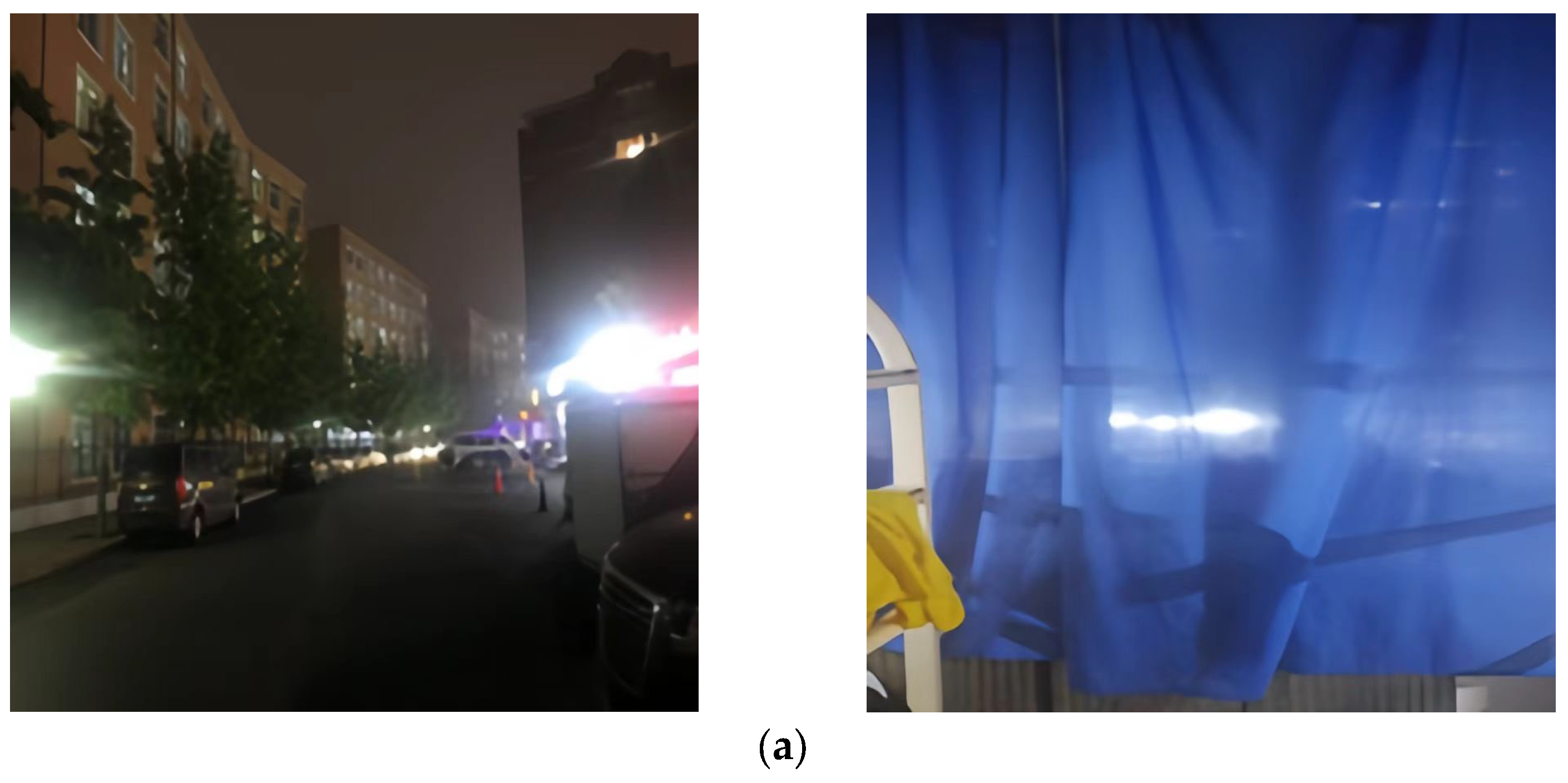
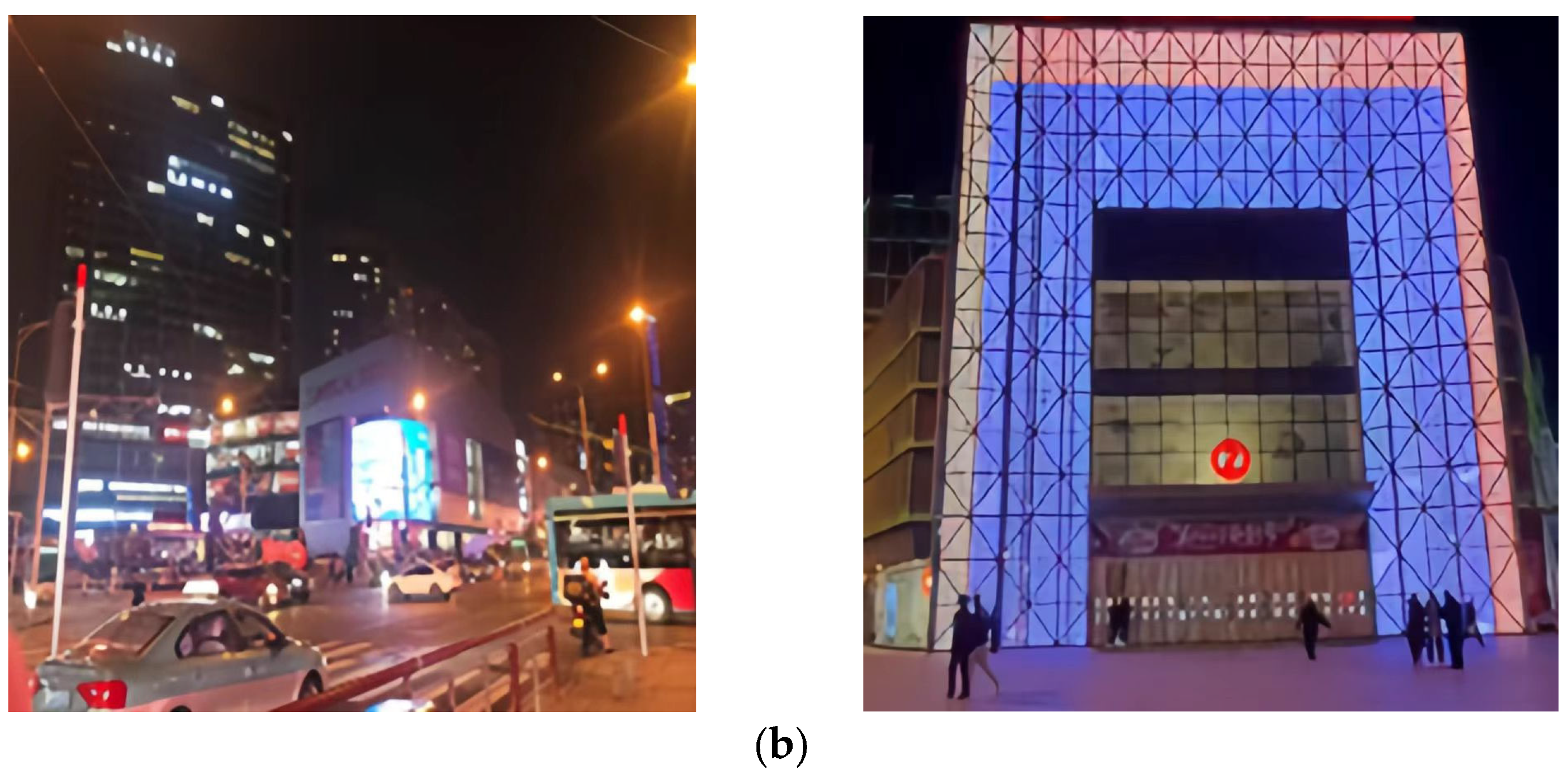
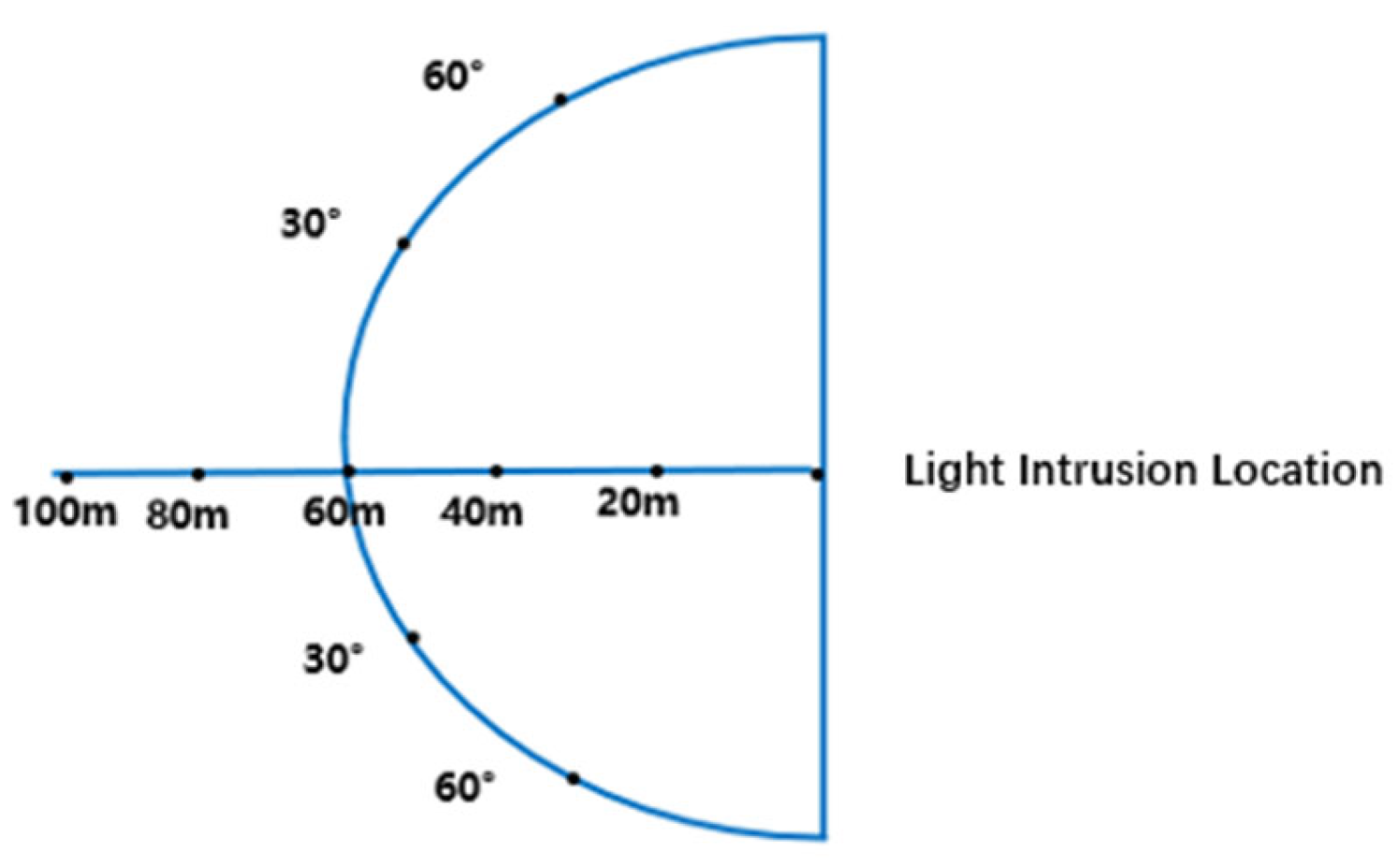
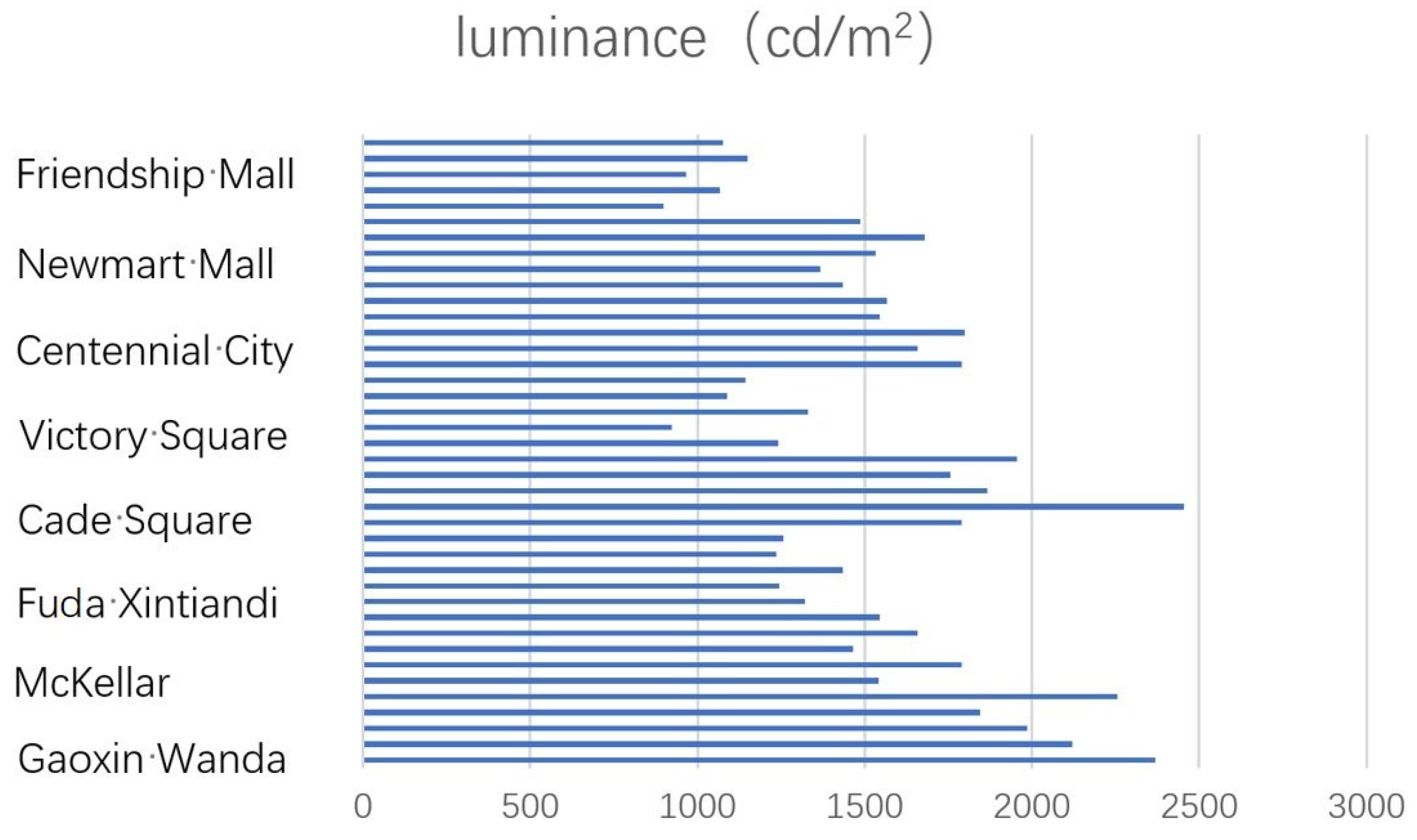
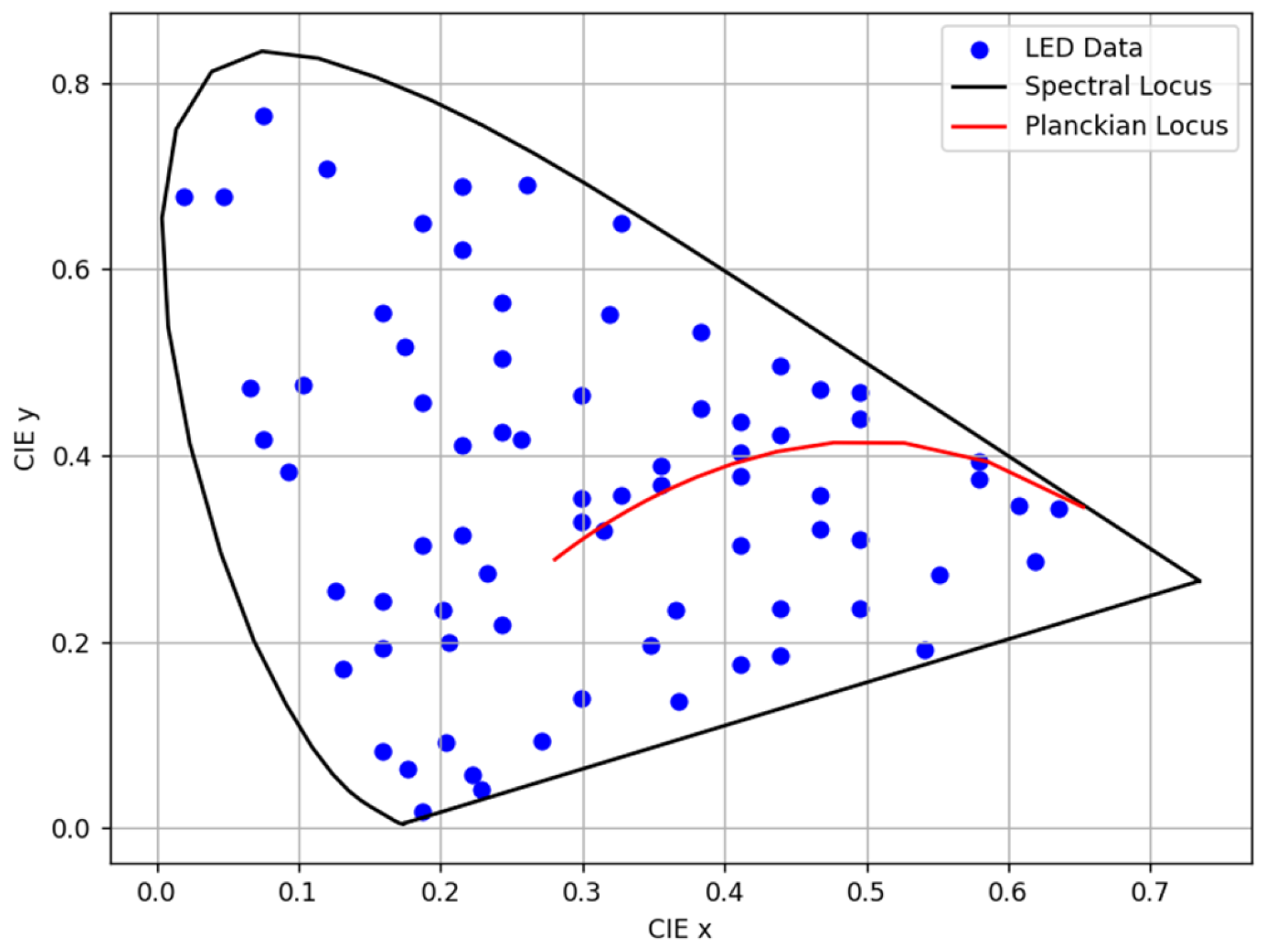
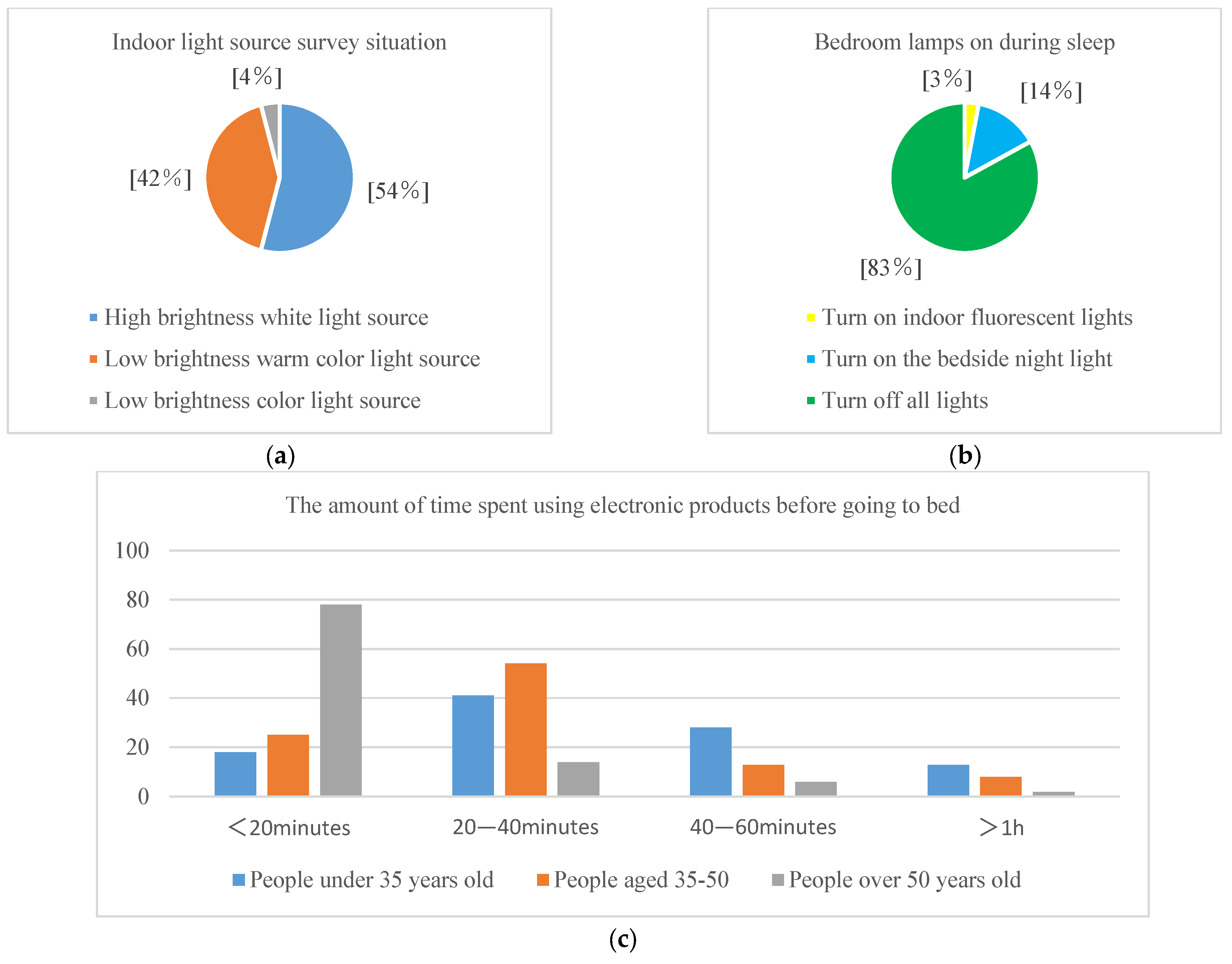
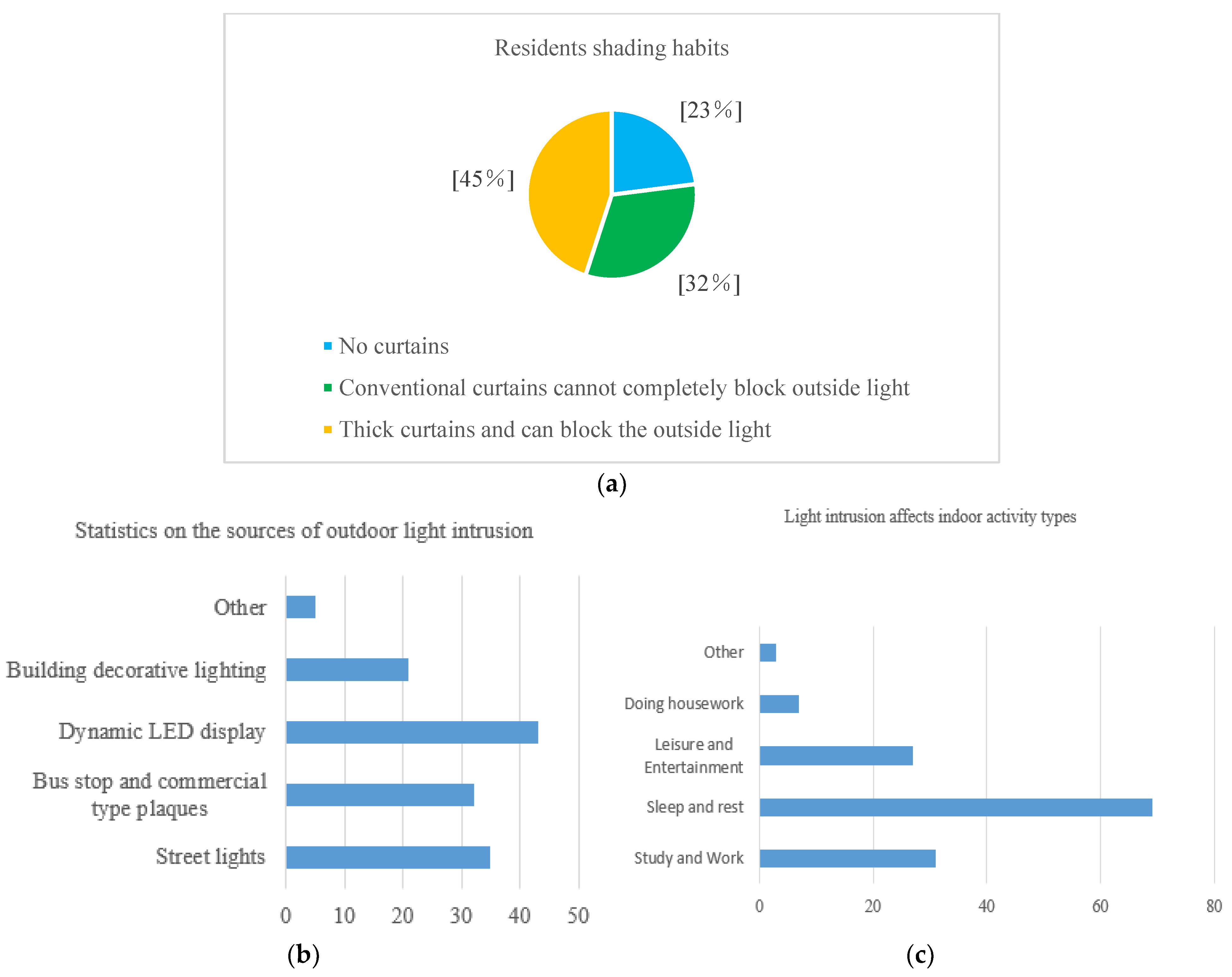
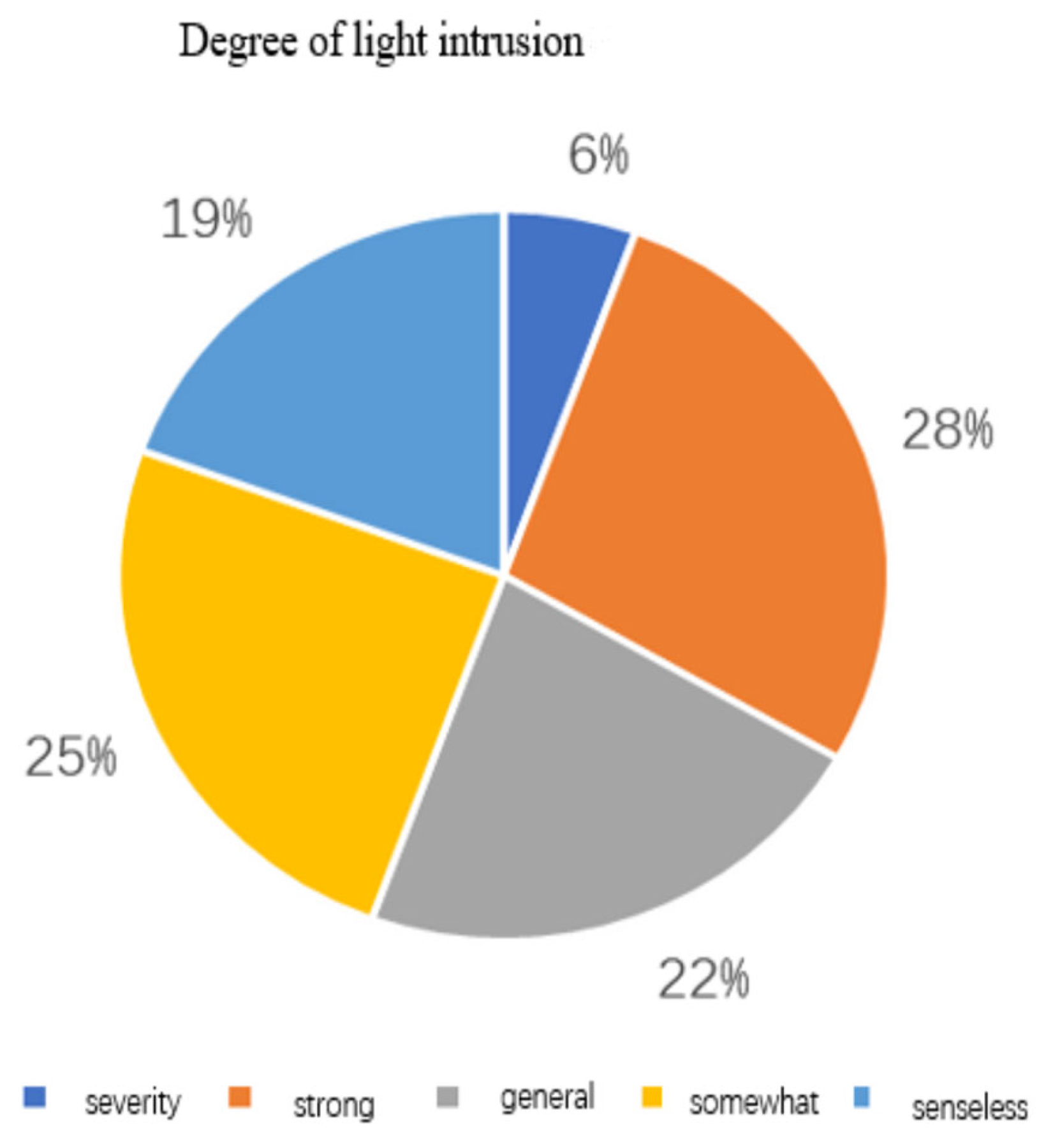

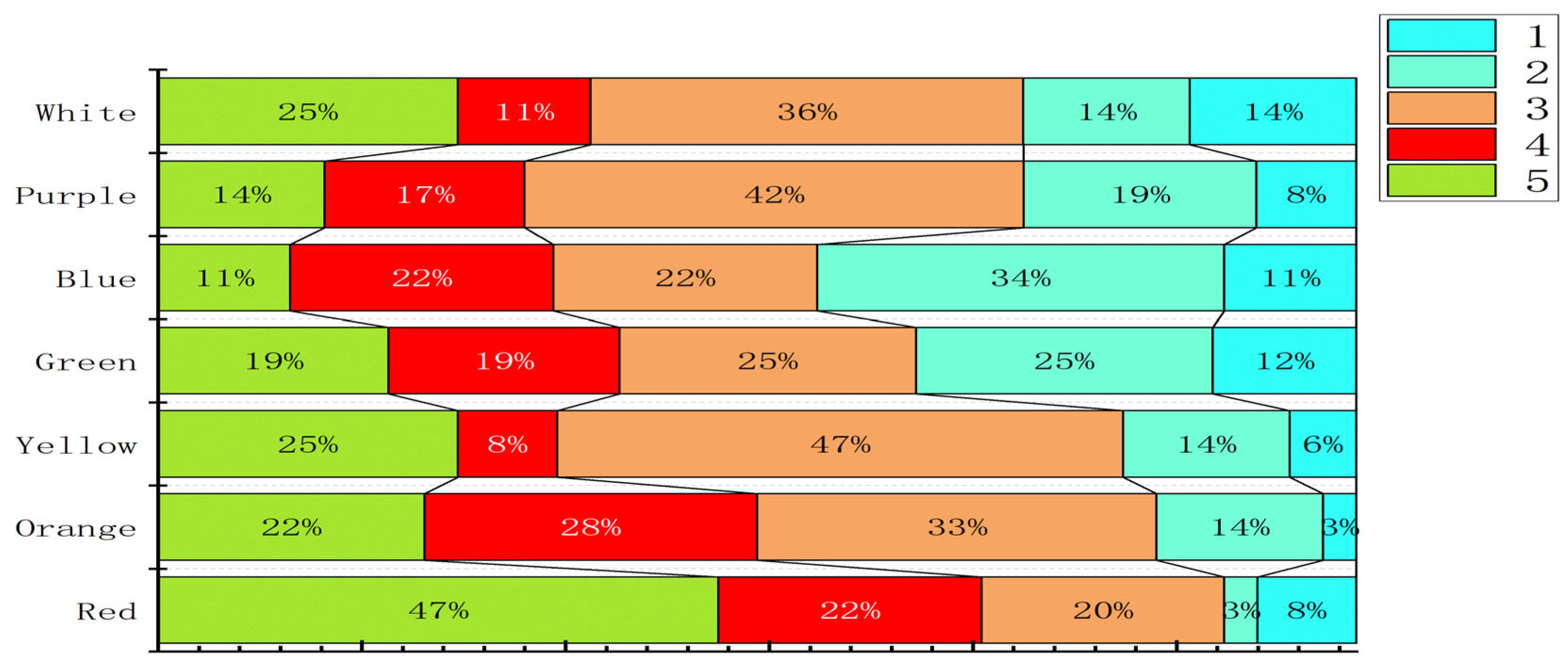
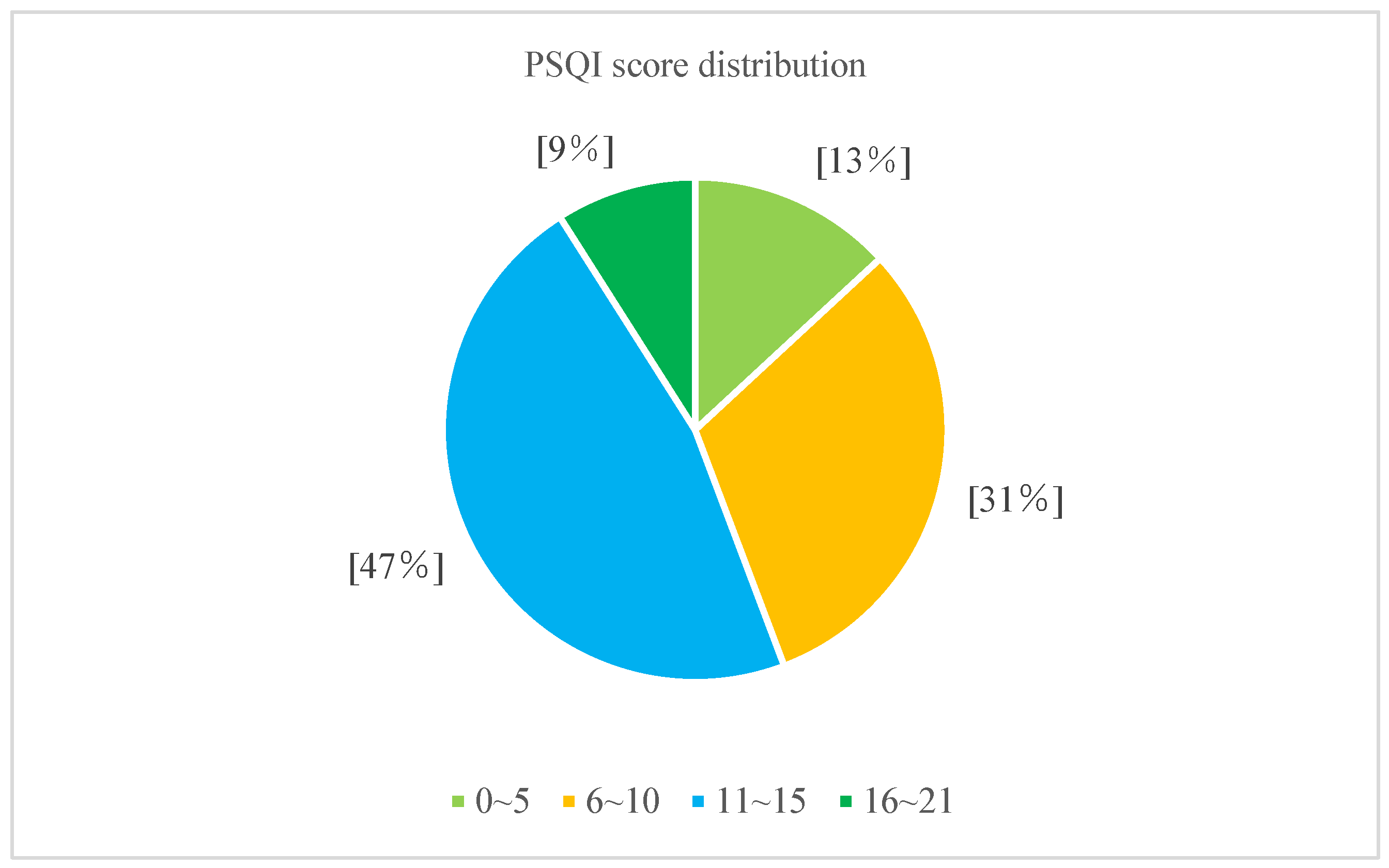
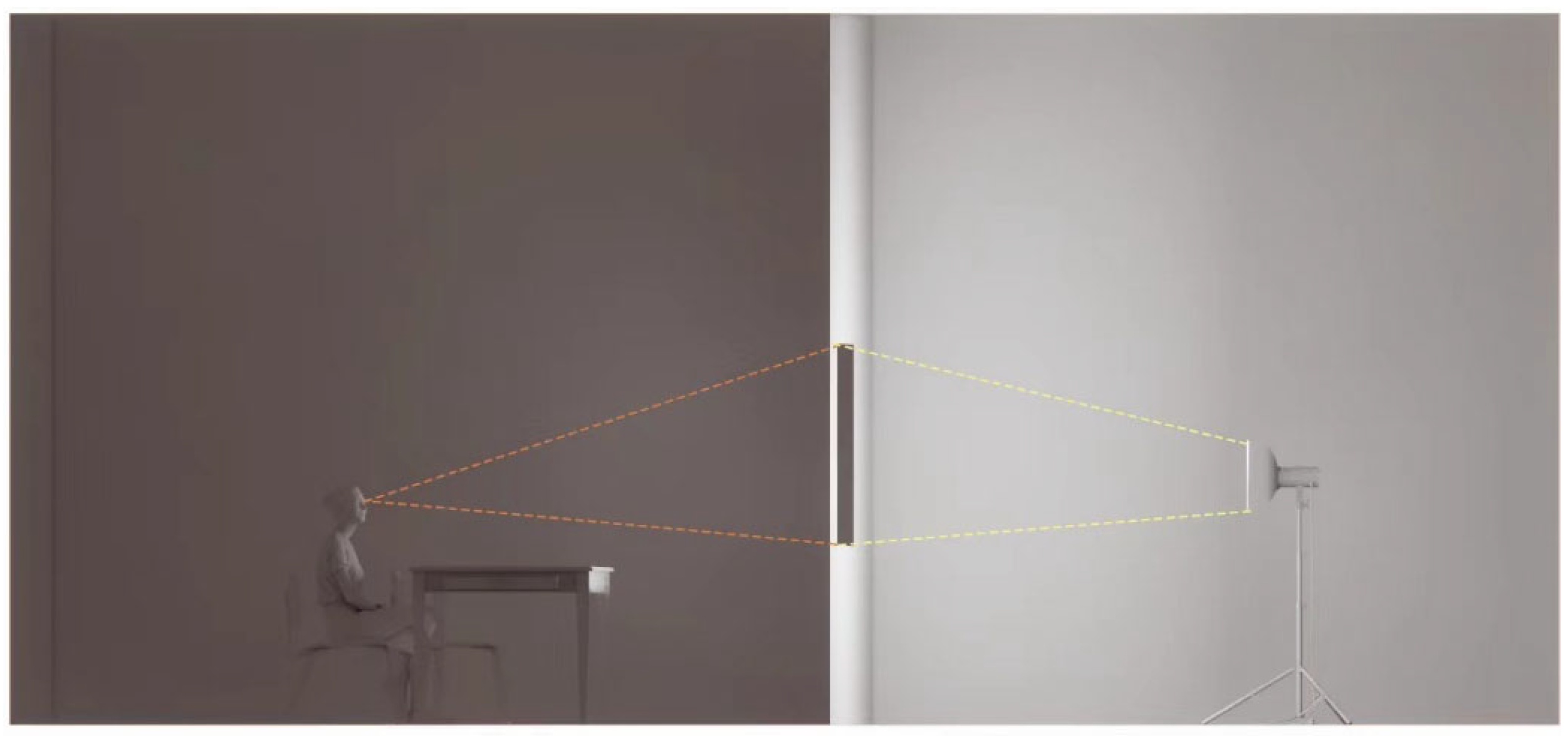
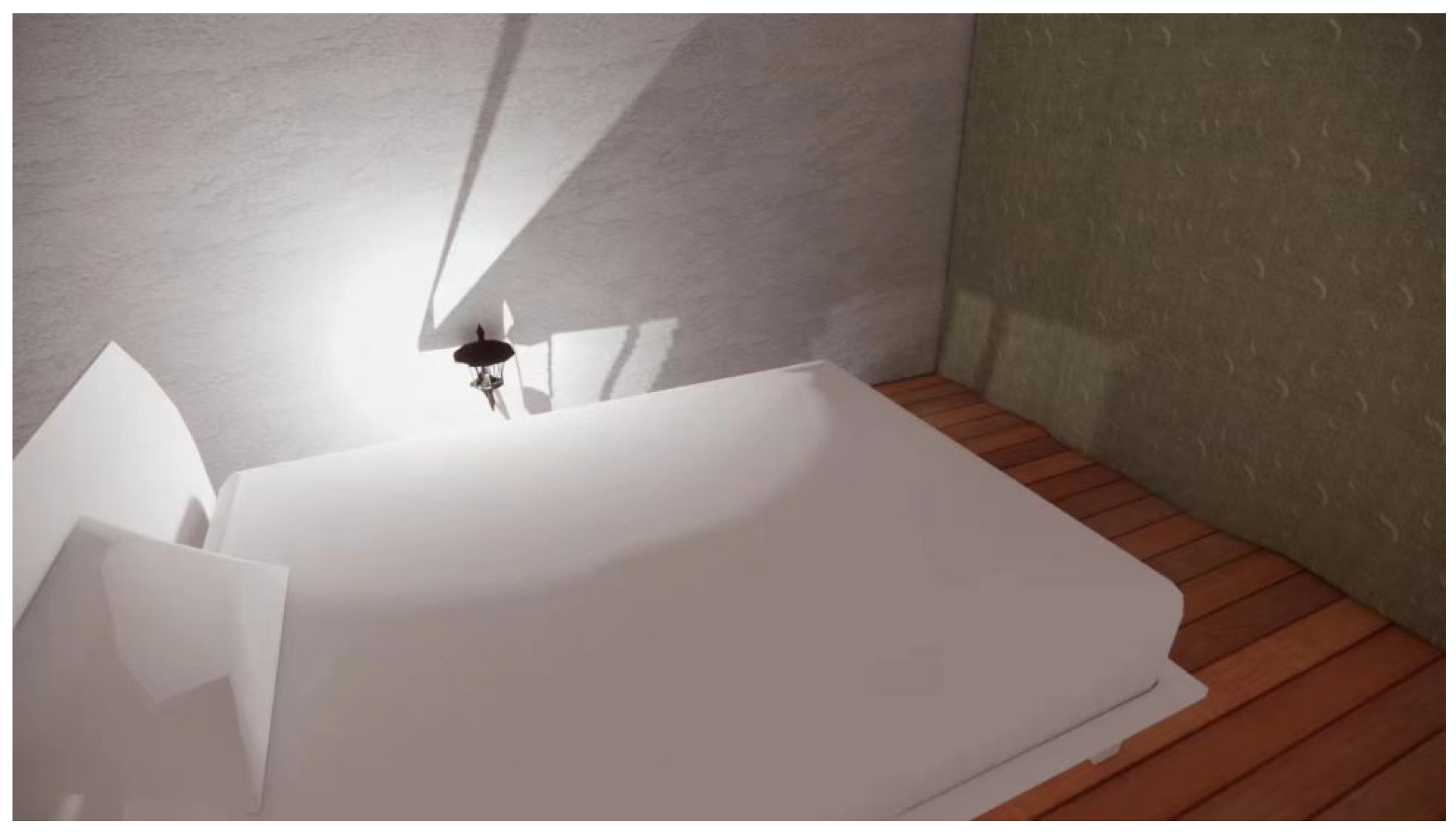
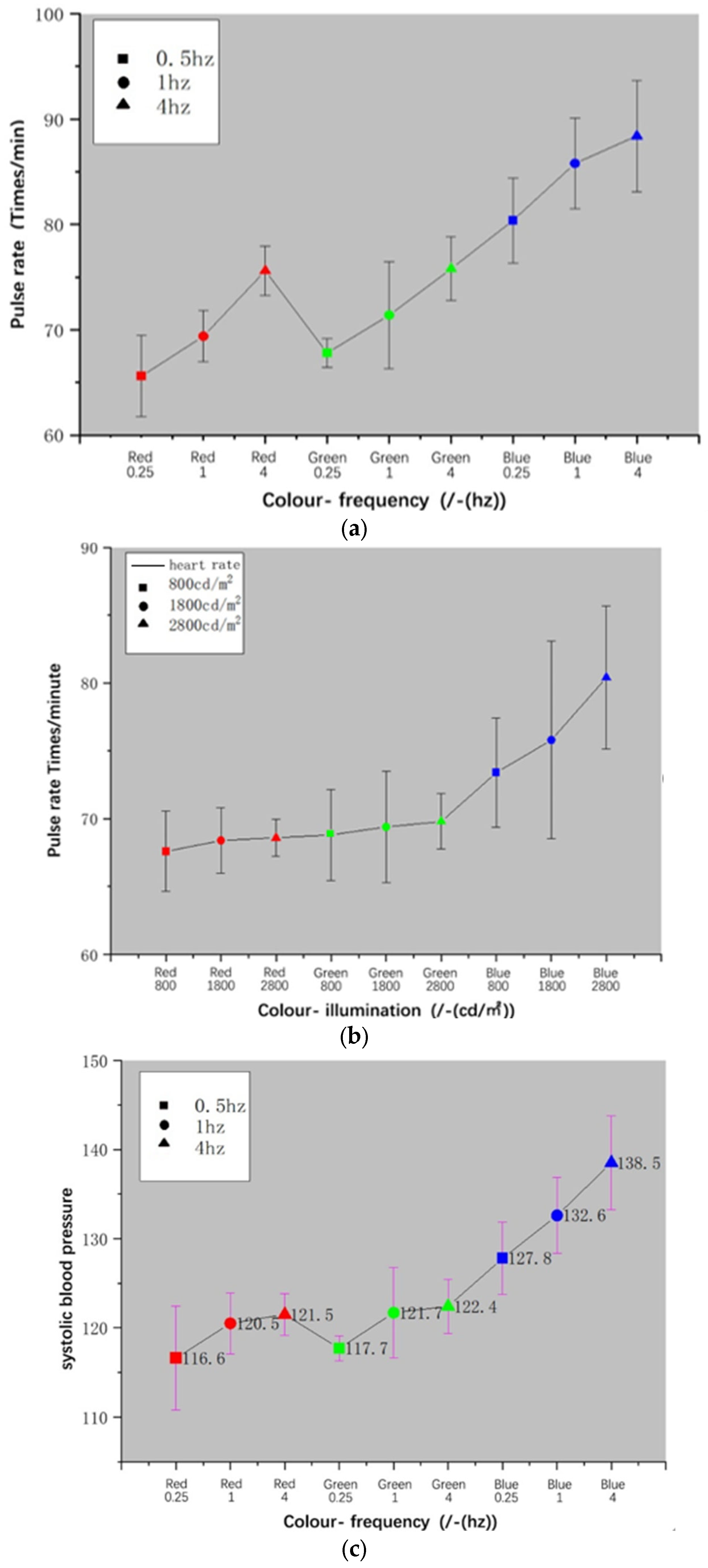
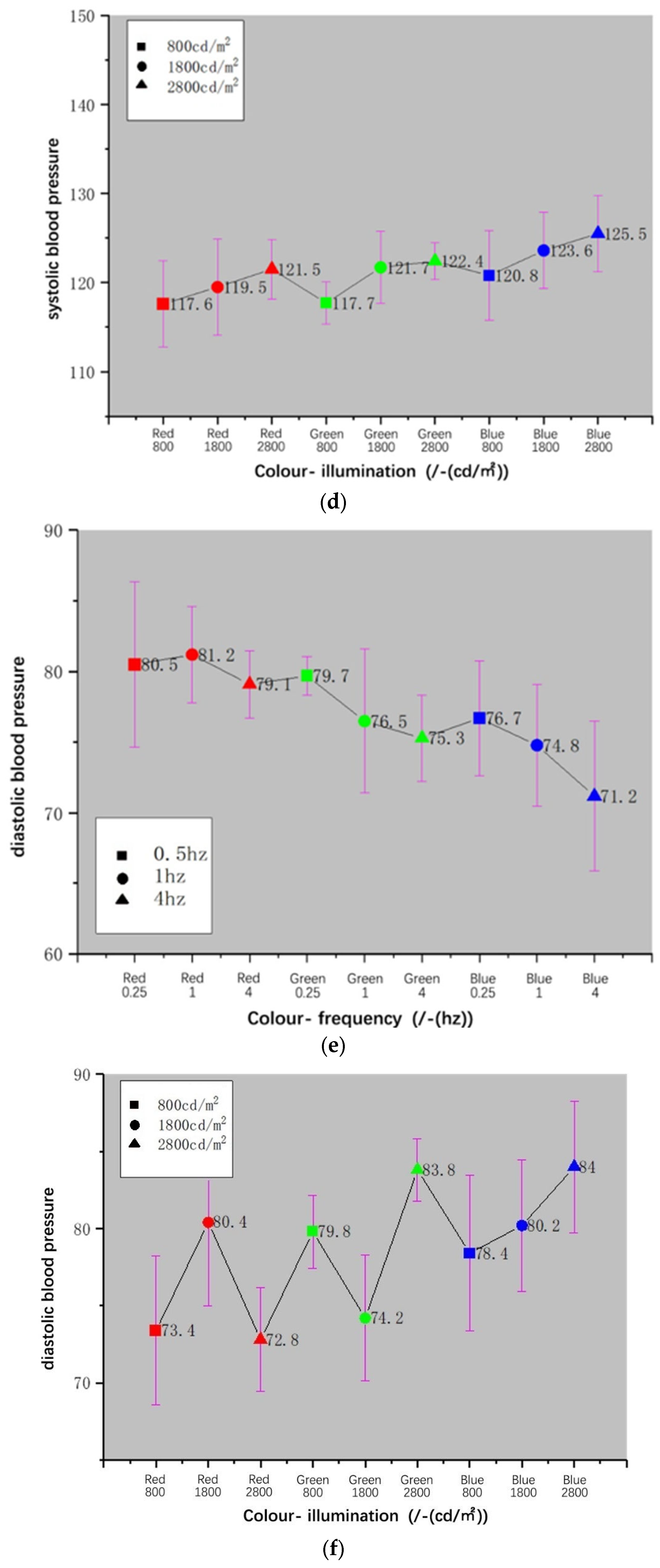
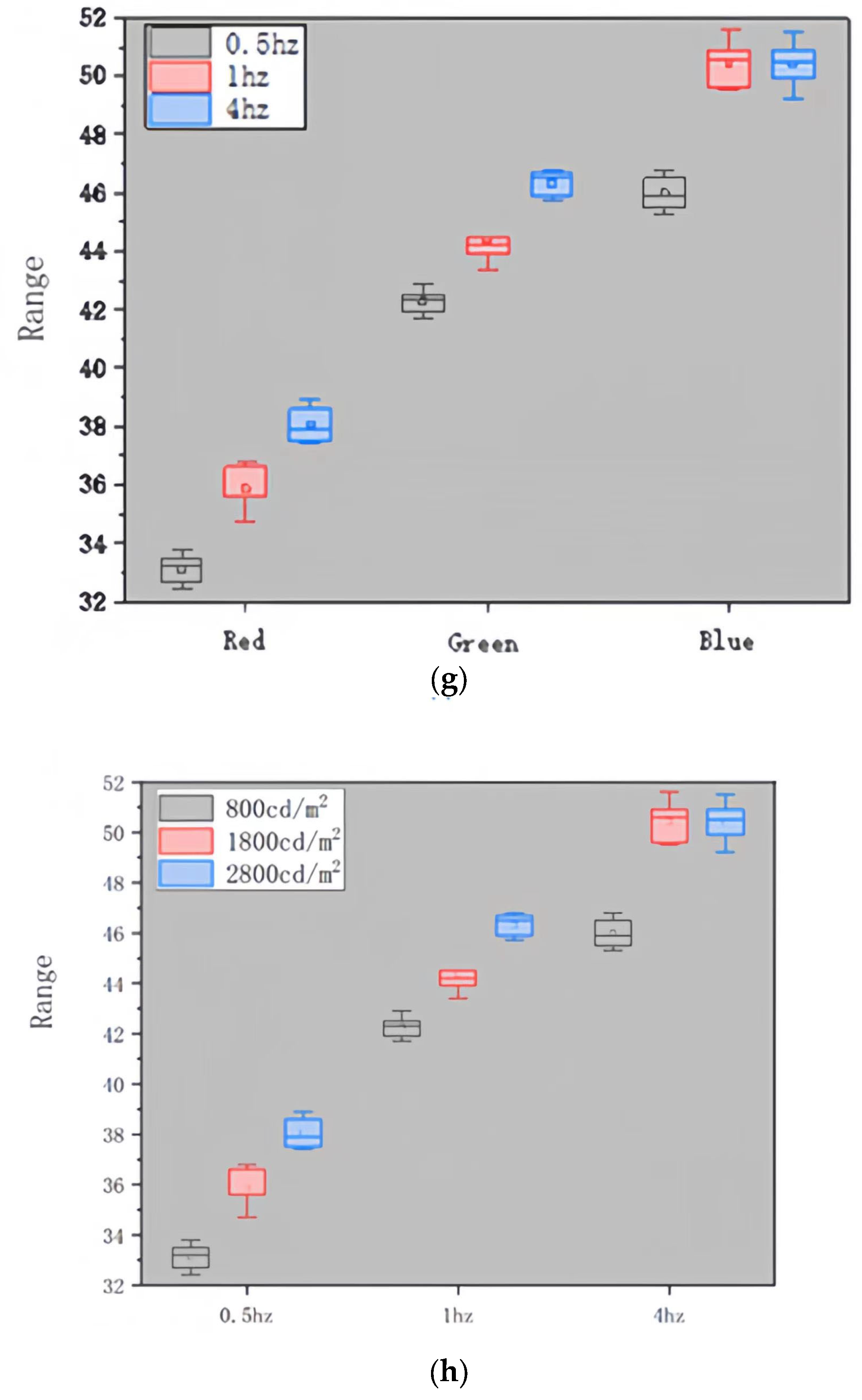
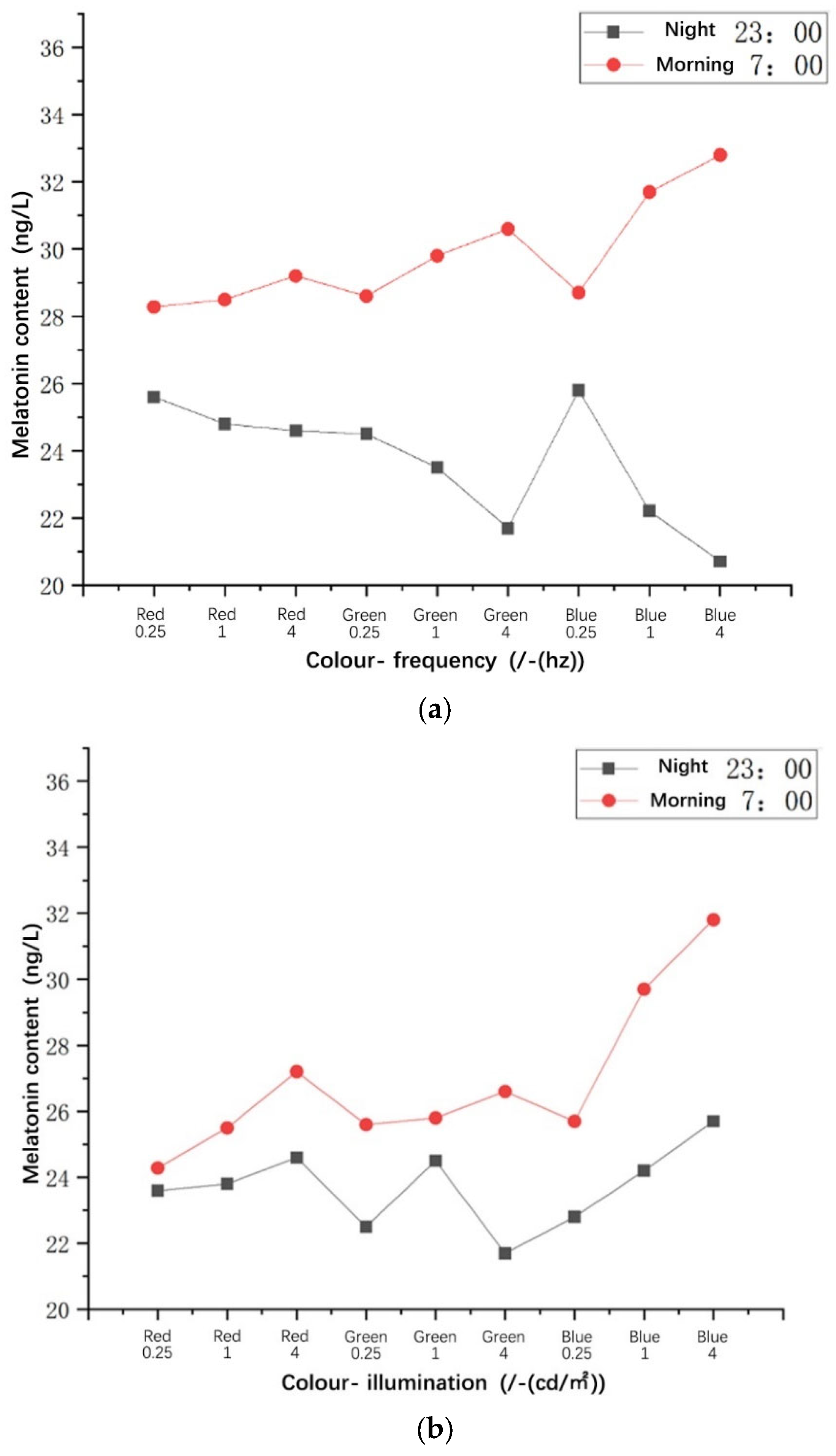
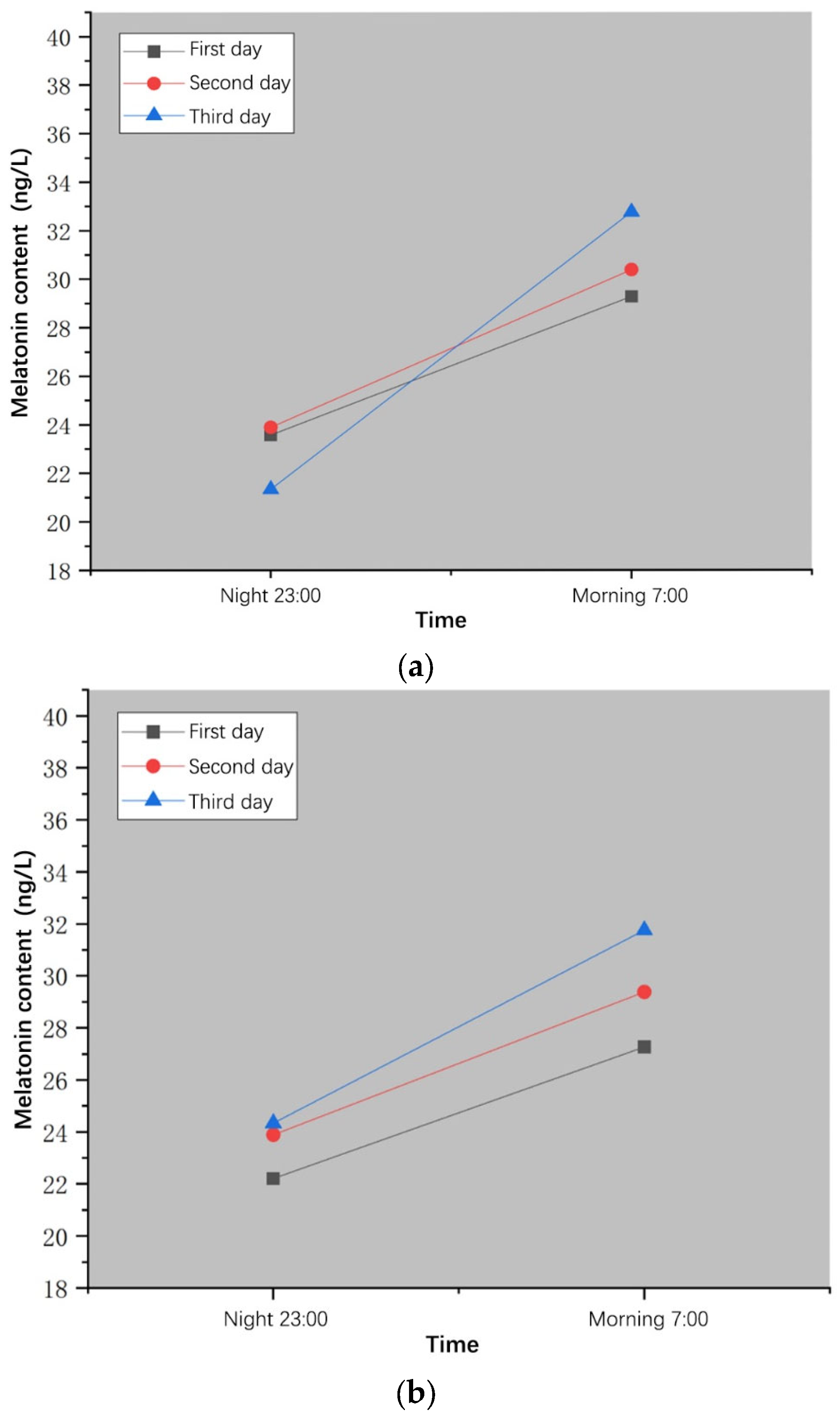
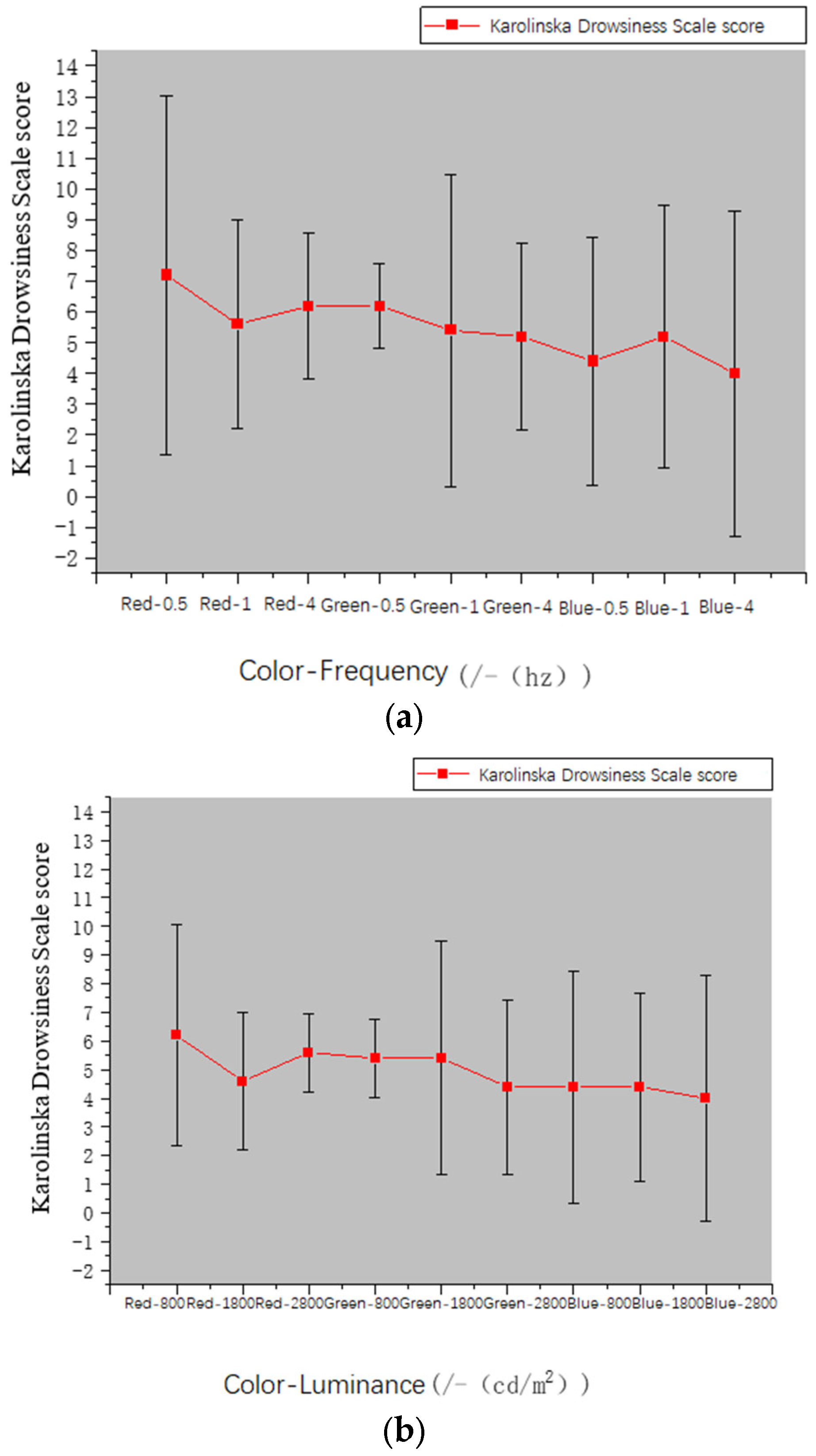
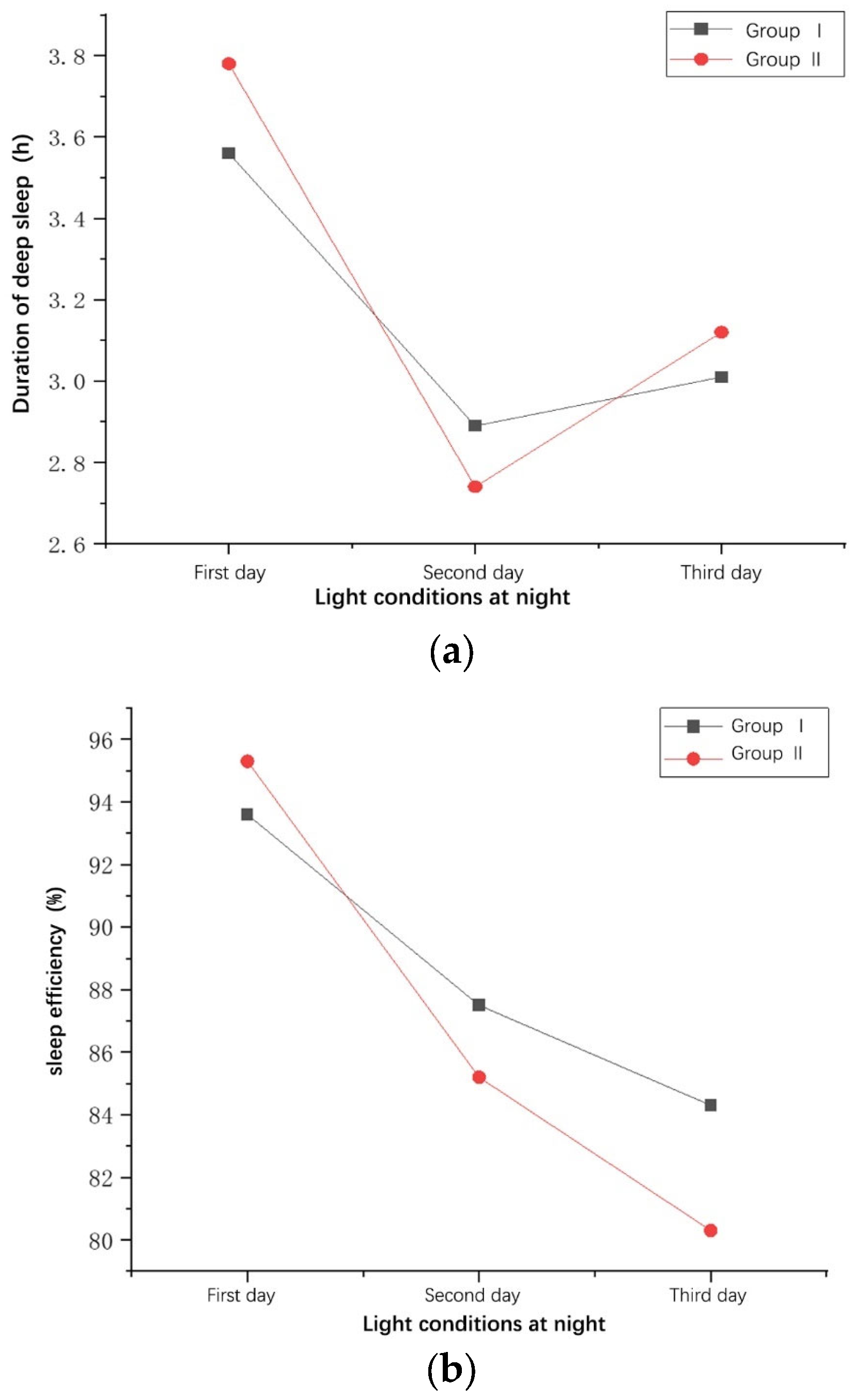
| Number | LED Advertising Screen Location | Affected Neighborhoods |
|---|---|---|
| 1 | Dalian Hi-Tech Wanda Plaza | Silicon Valley Holiday Community |
| 2 | Dalian Shaanxi Road McKellar | Tianxing New Home |
| 3 | Xi’an Road Tianxing Roosevelt | Changping District |
| 4 | CapitaLand Peace Plaza | New Hope Garden |
| 5 | Victory Plaza | Wuchang District |
| 6 | Centennial City | Chancery Lane |
| 7 | New Mart Shopping Plaza | Lido Garden |
| 8 | Youyi Mall | Harmony Garden |
| Laboratory Instruments | Measurement Data | Measurement Range | Accurate |
|---|---|---|---|
| CA-2500 2D Color Brightness Meter | Two-dimensional measurement of luminance distribution and chromaticity distribution of the display. | 0.05 ~ 100,000 cd/m2 | ±3% |
| CL-500A Illuminance Meter | Measurement of vertical illuminance, color temperature, dominant wavelength, and other parameters of windows in residential areas | 0.1–100,000 lx (Chromaticity display above 5 lx) | ±2% ±1 value of the displayed value |
| laser distance meter | Measurement of the distance between the light source and the measurement point | 120 m | ±2 mm |
| 1. Gender: Male ☐ Female ☐ |
| 2. Age: 18–35 ☐ 35–50 ☐ >50 ☐ |
| 3. Do you have a chronic disease: No ☐ Heart Disease ☐ High Blood Pressure ☐ Bone and Joint Disease ☐ Diabetes ☐ Respiratory Disease ☐ Depression ☐ Other ☐ |
| 4. Your satisfaction with the heat and humidity in your bedroom in the last month: Very satisfied ☐ Satisfied ☐ Fair ☐ Dissatisfied ☐ Very dissatisfied ☐ |
| 5. Your level of fatigue at work in the last month: Stronger ☐ Strong ☐ Moderate ☐ Not strong ☐ Weaker ☐ |
| 6. In the last month, your bedtime was ; Wake up time was ; The actual sleep time was |
| 1. Your exposure to indoor light sources prior to sleep: High brightness white light source ( ) Low brightness warm light source ( ) Low brightness colored light source ( ) |
| 2. Your habit of turning on and off the lamps in your bedroom when you sleep: Turn on indoor fluorescent lights ( ) Turn on bedside night light ( ) Turn off all lights ( ) |
| 3. How long do you use electronic products before going to bed every day? Less than 20 min ( ) 20–40 min ( ) 40–60 min ( ) more than 1 h ( ) |
| 4. Your usual shading habits: Do not pull the curtains ( ) Regular curtains cannot completely block the outside light ( ) Thick curtains and can block the outside light ( ) |
| 5. Does your living environment suffer from the intrusion of outdoor light sources? Yes ( ) No ( ) (1) If so, which aspect do you think is most affected? (Multiple choice) Study and work ( ) Sleep and rest ( ) Leisure and entertainment ( ) Housework ( ) Other ( ) (2) Which of the following factors do you think influence outdoor light? (Multiple choice) Street lights ( ) Bus stops and commercial plaques ( ) Dynamic LED display ( ) Building decorative lighting ( ) |
| 6. Combined with your living environment, do you think there are other sources of light exposure? |
| 1. What is the degree of influence of outdoor light intrusion on your living environment? No feeling ( ) Somewhat ( ) General ( ) Stronger ( ) Severe ( ) |
| 2. What do you mind most about the influence of advertisement signboards on you? Too bright ( ) Hate the color of the light ( ) Still bright after a break ( ) Alternating colors of light ( ) Brightness fluctuates ( ) The luminous area of the billboard ( ) |
| 3. Please rate the degree of annoyance towards the color of light intrusion (1~5 represents the degree of annoyance in increasing order) Red ( ) Orange ( ) Yellow ( ) Green ( ) Blue ( ) Purple ( ) White ( ) |
| 4. Last 1-month sleep survey: Pittsburgh Sleep Quality PSQI score ( ) |
| Type | Color Change | Blinking | Sliding | Extending | Jumping |
|---|---|---|---|---|---|
| Description | Only refers to color change | Only refers to alternating light and dark changes | Single change continuous without interruption or position change | Single change continuous without interruption, starting point position unchanged, or shape change | Single change with interruption, position, or shape change |
| Frequency | 0.25–4 | 0.5–4 | 1–4 | 0.5–4 | 1–2 |
| Factors | Infestation Source Color | Blinking Frequency | Brightness |
|---|---|---|---|
| (-) | (Hz) | (cd/m2) | |
| Scenario 1 | Red | 0.25 | 800 |
| Scenario 2 | Red | 1 | 1800 |
| Scenario 3 | Red | 4 | 2800 |
| Scenario 4 | Green | 0.25 | 1800 |
| Scenario 5 | Green | 1 | 2800 |
| Scenario 6 | Green | 4 | 800 |
| Scenario 7 | Blue | 0.25 | 2800 |
| Scenario 8 | Blue | 1 | 800 |
| Scenario 9 | Blue | 4 | 1800 |
| Sequence | Average Value | R | R | R | Error | R | |||
|---|---|---|---|---|---|---|---|---|---|
| 1 | 39.148 | 44.234 | 4.532 | 41.156 | 5.535 | 42.345 | 2.976 | 43.133 | 1.564 |
| 2 | 44.236 | ||||||||
| 3 | 49.274 | ||||||||
| 4 | 39.645 | 41.487 | 43.712 | 43.876 | 43.956 | ||||
| 5 | 41.934 | ||||||||
| 6 | 42.876 | ||||||||
| 7 | 44.678 | 45.876 | 46.745 | 45.356 | 44.574 | ||||
| 8 | 44.578 | ||||||||
| 9 | 48.065 |
Disclaimer/Publisher’s Note: The statements, opinions and data contained in all publications are solely those of the individual author(s) and contributor(s) and not of MDPI and/or the editor(s). MDPI and/or the editor(s) disclaim responsibility for any injury to people or property resulting from any ideas, methods, instructions or products referred to in the content. |
© 2025 by the authors. Licensee MDPI, Basel, Switzerland. This article is an open access article distributed under the terms and conditions of the Creative Commons Attribution (CC BY) license (https://creativecommons.org/licenses/by/4.0/).
Share and Cite
Zhang, B.; Li, J.; Liu, M.; Li, R.; Zhao, K.; Guo, L.; Liu, M. A Study on the Effect of Nighttime Light Intrusion on the Phase Shift of Human Rhythms. Buildings 2025, 15, 946. https://doi.org/10.3390/buildings15060946
Zhang B, Li J, Liu M, Li R, Zhao K, Guo L, Liu M. A Study on the Effect of Nighttime Light Intrusion on the Phase Shift of Human Rhythms. Buildings. 2025; 15(6):946. https://doi.org/10.3390/buildings15060946
Chicago/Turabian StyleZhang, Baogang, Jiayu Li, Ming Liu, Ruicong Li, Kehui Zhao, Lingling Guo, and Mingxuan Liu. 2025. "A Study on the Effect of Nighttime Light Intrusion on the Phase Shift of Human Rhythms" Buildings 15, no. 6: 946. https://doi.org/10.3390/buildings15060946
APA StyleZhang, B., Li, J., Liu, M., Li, R., Zhao, K., Guo, L., & Liu, M. (2025). A Study on the Effect of Nighttime Light Intrusion on the Phase Shift of Human Rhythms. Buildings, 15(6), 946. https://doi.org/10.3390/buildings15060946





